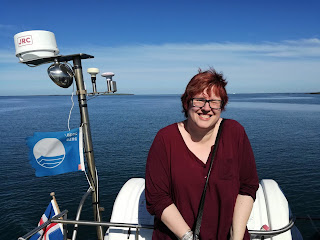 Trip to the island of Viðey
Trip to the island of Viðey
When we were in Iceland in June, I really wanted to take a trip to the island of Viðey - I had just looked specifically into the cuisine of the capital region and came across wild cumin, which is traditionally used in Icelandic cuisine as a spice in baking and is sometimes also used in cooking - and of course for the production of Brennivín. Wild cumin grows particularly abundantly on Viðey; many residents of the city still go to Viðey in the autumn to pick caraway there.
Okay, June is the wrong time of year for picking - but I definitely wanted to get a personal impression!
The island is located just off the coast of Reykjavík. From Skarfabakki harbor you can reach the island after a short ferry crossing. In summer (May 15th to September 30th) the ferry runs hourly from Skarfabakki from 10:15 a.m. to 5:15 p.m., returns from Viðey from 11:30 a.m. to 6:30 p.m. In addition, in summer the ferry leaves twice a day from the old port in Grandi or from Harpa and the ferry also stops at the two berths three times on the way back. In winter (October 1st to May 14th) the ferry only runs on weekends and only 3 times a day. For an adult, the return trip currently costs 1,600 ISK, the equivalent of around €11.30.
We spontaneously drove over to Viðey on Saturday morning with the first ferry at 10:15 a.m.
We were really incredibly lucky with the weather, such a bright blue sky, such a calm blue sea, such a great view!
The ride was just a lot of fun, even though it only really lasted a few minutes.
Apart from us and a group of Asian tourists, there were only Icelanders on board; later we met mainly older couples and families with children on the island.
Viðey is the largest of the islands here in Kollafjörður with an area of approximately 1.7 km². The highest point on the island is about 32 m above sea level. The people here are proud - Videy is about the size of Monaco. However, over 38,000 people live in Monaco, about 18,700 per km².
The island of Viðey was also populated - according to archaeological finds, the island was settled by Vikings as early as the 10th century. There was even an Augustinian monastery on Viðey from the 13th to 16th centuries, but it was attacked by Danish soldiers during the Reformation and finally abandoned in 1550 after the murder of Jón Arason, the last Catholic bishop of Iceland.
The Viðeyjarstofa manor was built on Viðey in 1753-55 for Skúli Magnússon, the "Father of Reykjavík". The house was the first stone house in Iceland. Skúli died on the island in 1794 and was buried under the age of the church he had built in 1774.
The church and manor house later went to the Icelandic state. For the 200th anniversary of the city of Reykjavík in 1986, the state donated the then very dilapidated buildings to the city of Reykjavík. It has been extensively renovated and remodeled and is now used as a museum and restaurant.
The old schoolhouse was also extensively renovated and restored and now serves as an event room. There is also a photo exhibition about the history of the place and, very importantly, here is the island's public toilet, which is open daily until 5:30 p.m.
In the meantime we were really waist deep in greenery on the way, here I'm standing in the middle of a lot of angelica. And I really love angelica when cooking and baking - so it's a fantastic feeling for me to be right in the middle of it!
At the beginning of the 20th century, a port with fishing and fish processing was built on Viðey, and a village was subsequently built on the island, which was inhabited from 1907 to 1943. At its peak in 1930, 138 people lived in this village.
Since 1932, however, the port's economy has declined sharply and the village was abandoned in 1943. Today only a few remnants of the wall can be seen from the former port, the work buildings and the village (apart from the old schoolhouse).
Later we found what I was looking for - near the manor house we came across Skúli Magnússon's reconstructed garden.
(The boat in the foreground is a sandpit for children.)
Incidentally, Skúli Magnússon had a lasting influence on Icelandic cuisine in his time by bringing fruit and vegetable plants to Iceland that were often not known here before, for example bush fruits such as currants.
And we were also able to clearly identify my cumin!
Another attraction on Viðey is of course the “Imagine Peace Tower”, the “Friðarsúlan”, the “Peace Column”.
Yoko Ono, John Lennon's widow, created a light installation here in 2007. In the "pillar" 15 spotlights are arranged in a circle, which send a blue-white column of light several kilometers high vertically into the sky over Reykjavík every year from John Lennon's birthday (October 9th) to the day of his death (December 8th). On the white pillar is engraved "Imagine Peace" - "Hugsa sér frið" in 24 languages.
We then walked around a bit on the northern part of the island.
If I ever had a really awesome party, then this glass house over the sea (open from May 1st to October 1st) would definitely be my dream location!
We then briefly went to the restaurant before we took the ferry back to the city at 2:15 p.m. after a great time on Viðey.
Oh well, as a reminder of the great day on Viðey I got a serious sunburn - the weather was just too good!
[Translated from here.]


































No comments:
Post a Comment